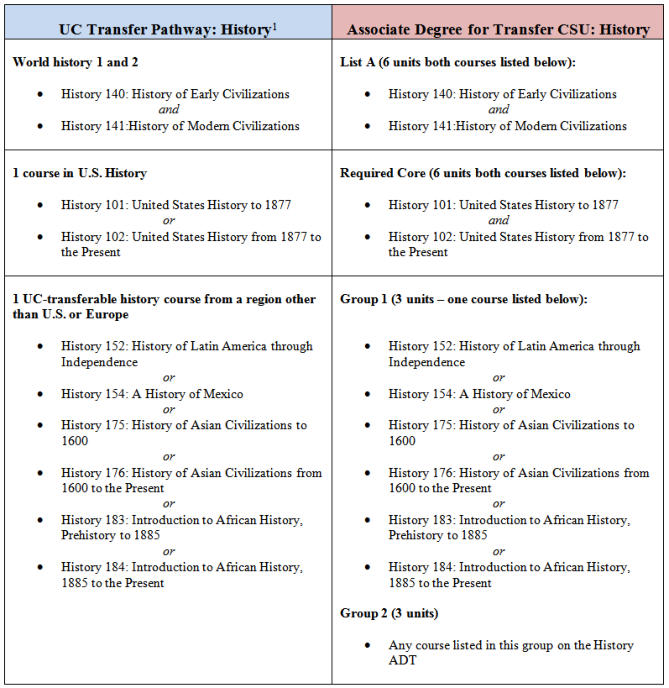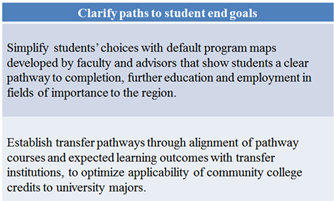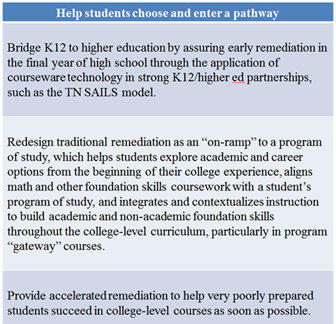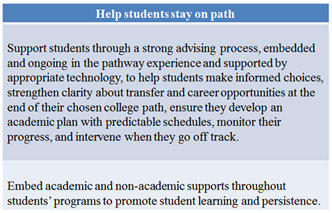

Student Equity Reenvisioned
SER
Guided Pathways
A SER Proposed Model
Guided Pathways
In an effort to increase student success, the California Community College system is now participating in a
national organized reform designed to improve community college outcomes. Referred to as Guided Pathways,
this model is “based on coherent and easy-to-follow college-level programs of study that are aligned with
requirements for success in employment and at the next stage of education.” More specifically, this attempt at
reform has manifested itself in California under the title of The California Guided Pathways Project. It is
directed by the California-based National Center for Inquiry & Improvement and coordinated by the Foundation
for California Community Colleges. The aim of Guided Pathways is to “to help students clarify their goals,
choose and enter pathways that will achieve those goals, stay on those pathways, and master knowledge and
skills that will enable them to advance in the labor market and successfully pursue further education.” This is
accomplished by redesigning and/or realigning college programs, support services and instructional approaches.
Using the Guided Pathways model, students are assisted in:
•
Exploring academic and career options
•
Choosing a program of study
•
Developing a plan based on the program maps
The integrative approach to undergraduate education through the Guided Pathways model serves to:
•
“Simplify student decision-making . . .”
•
“Enable colleges to provide predictable schedules, frequent feedback, and targeted support as needed to
help students stay on track and complete their programs more efficiently. . . ”
•
“Facilitate efforts by faculty to ensure that students are building the skills across their programs that they
will need to succeed in employment and further education . . .”
The Challenge
Initially, it appears that most Guided Pathways models in California focus on creating what is termed meta-
majors and then group under those categories relevant associate degrees including AA/AS and ADT degrees as
well as certificate programs offered. Within the context of transfer, the ADTs and/or major specific articulation
agreements available on ASSIST already serve as a “Guided Pathway” for CSU-bound students. Similarly,
completion of IGETC and a UC transfer pathway and/or the major preparation requirements on ASSIST serve
as a “Guided Pathway” for UC-bound students. Consequently, what most community colleges seem to be
leaning towards at this point is “repackaging” what already exists while trying to increase the integration of
student support services into this framework. Bakersfield Community College exemplifies this model as it has
created ten meta-majors and provides a “list of completion coaches and programs of study for each category.”
The programs of study are the ADTs they offer.
The reality is that most California community colleges are somewhat perplexed on how to implement Guided
Pathways. In response, the Institutional Effectiveness Partnership Initiative (IEPI) and the California
Community Colleges Chancellor's Office have coordinated a series of workshops to provide guidance and
examples. To a certain extent, the obstacles experienced by California community colleges in implementing
Guided Pathways as it relates to transfer are fueled by the following:
•
Transfer curriculum is prescribed and determined by UC and CSU campuses leaving community colleges
with little control to determine transfer requirements. Narrowing down student course options does not
exempt them from having to fulfill the requirements and may be detrimental to self-exploration.
•
Transfer initiatives such as UC Transfer Pathways and SB 1440, which has triggered the design of
Associate Degrees for Transfer, have provided some curricular alignment within majors, but these efforts
are still under the purview of the UC and CSU systems respectively.
•
External factors that affect a student’s ability to achieve their educational success are not explicitly
addressed under the present Guided Pathways framework. For example, financial challenges, life
responsibilities outside of education, personal and emotional challenges, and a lack of academic
foundations necessary to succeed in higher education.
History Guided Pathways Map
To further facilitate educational goal completion, a discipline specific Guided Pathways Map for students that
aligns the UC Transfer Pathway with CSU Associate Degrees for Transfer was created. The aim of this
program map is to simplify major course selection for students while providing transfer flexibility into either
the UC or the CSU systems. The first step to creating this map was to align the requirements for the History
major for both systems. The table below shows the alignment for the UC Transfer Pathway requirements and
ADT requirements. By completing the recommended courses in the ADT column the student fulfills both
requirements.
Once this alignment was accomplished , a Guided Pathways Map for History majors was created that
simplified the choices for students. Once again, using this map allows a student complete the ADT in History
and the UC Transfer Pathway requirements. Please see the draft of this map bu clicking on the link below.
History Guided Pathways Program Map - Draft
The model developed by SER/History Department has campus wide application and can serve as template for
successfully bridging the academic and student services sectors for the purpose of facilitating the
implementation of Guided Pathways. Introductory courses for other division that can serve the same purpose as
ECC’s SOCS 101 already exist at other community colleges. For example, Humanities 101: Introduction to the
Humanities is a 3 unit transferable course to UC/CSU offered at San Diego City College. STEM 101:
Introduction to Science, Technology Engineering and Mathematics is a 3 unit transferable course to the
UC/CSU offered at Santa Barbara City College. Discipline specific Guided Pathways Maps facilitate the
course selection majors declared by students after completing the introduction courses.

A SER Proposed Model
In working with El Camino College’s History Department, a framework was created that seeks to accomplish
the objectives of Guided Pathways as follows:
•
By having students enroll in a foundational course that introduces them to the different programs of
study within the Social Sciences (History being one of them) and that also embeds academic counseling,
career planning and academic skills set development.
•
By illustrating to students the alignment of courses required by the University of California Transfer
Pathway with those required by California State University’s Associate Degree for Transfer.
With vision towards addressing equity gaps and Guided Pathways, SER in collaboration with the History
Department developed an interdisciplinary course entitled Social Science 101: Introduction to the Social
Sciences. Social Science 101 addresses the four pillars of Guided Pathways and student equity in the following
ways:
•
It introduces students to programs of studies in the Behavioral and Social Sciences.
•
It integrates academic counseling and career counseling into the course.
•
It instructs students on the academic skill sets associated with the Behavioral and Social Sciences.
•
It integrates high-impact practices to ensure students are learning.
In the best of all possible worlds, Social Science 101 should be taught as a learning community with an English
1A course. However, Social Science 101 can also be offered as a stand-alone course. Below is an example of
what a first year student’s schedule would look like who is interested the Behavioral and Social Sciences and is
enrolled in Social Science 101.
First-Year Student Education Plan - BSS Focus




History Guided Pathways Map Courses
Those courses which are part of the History Guided Pathways Map will ensure that the four pillars of Guided
Pathways are addressed. These objectives have been adopted from the California Guided Pathways Project
model.
To meet this program map objective, the History
Department has created a transfer pathway/student
education plan that aligns all the courses that meet the
UC Transfer Pathway and the Associate Degree for
Transfer requirements for the History major. In addition,
the completion of this transfer pathway/education plan
also qualifies a student for the AA-T in History and for
the UC TAG. Students are advised to regularly visit the
UC TAG website or specific requirements and
participating UC campuses in the UC TAG program.
Students are also advised to regularly visit CSU Student
Transfer for CSU campuses that have identified history
as a similar major.
Guided Pathway designated history courses will
continue to re-enforce throughout the semester the
foundational skills needed for both success in college-
level curriculum and success as a history major. These
courses will explore integrating the Reading
Apprenticeship Framework, Growth Mindset, writing as
a method of learning about discipline-specific
conventions, educational neuroscience lesson designs
and blended learning designs to re-enforce foundational
skills (example). In addition, faculty teaching these
courses will serve as mentors to students through
discipline-based career advisement.
Guided Pathway designated history courses will
integrate intrusive academic and career advising.
Counselors will visit the class on two occasions and will
conduct follow-up appointments with students. Blended
learning modules will lay the foundations for counselor
visits to the classroom (example). In addition, Guided
Pathway designated courses will use PASS Mentors.
The function of PASS Mentors “is to assist students
with course content in the classroom and in the PASS
sessions.” PASS Mentors meet on a weekly basis with
instructors “to discuss specific issues, content or
directed activities to be covered in PASS sessions [and]
to discuss the specific challenges students are having
with the course content.”
The History Department already has in place course
level and program level learning outcomes. To enhance
the learning experiences of students enrolled in the
Guided Pathway designated history courses, faculty will
also integrate high-impact practices that may include but
are not limited to service learning/community-based
learning, undergraduate research and signature work,
threshold concepts and wicked problems, collaborative
assignments and projects, and diversity and global
learning experiences.









Jason Suarez
SER Faculty Coordinator
Wendy Lozano
Student Services Specialist
Student Equity



















